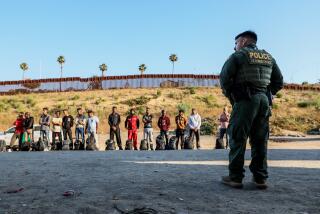7-year-old migrant girl taken into Border Patrol custody dies of dehydration and shock
- Share via
A 7-year-old girl from Guatemala died of dehydration and shock after she was taken into Border Patrol custody last week for crossing from Mexico into the United States illegally with her father and a large group of migrants along a remote span of New Mexico desert, U.S. Customs and Border Protection said Thursday.
The child’s death is likely to intensify scrutiny of detention conditions at Border Patrol stations and CBP facilities that are increasingly overwhelmed by large numbers of families seeking asylum in the U.S.
According to CBP records, the girl and her father were taken into custody about 10 p.m. Dec. 6 south of Lordsburg, N.M., as part of a group of 163 people who approached U.S. agents to turn themselves in.
At 6:25 a.m., the child began having seizures, records show. Emergency responders, who arrived soon after, measured her body temperature at 105.7 degrees, and according to a statement from CBP, she “reportedly had not eaten or consumed water for several days.”
After a helicopter flight to Providence Hospital in El Paso, the child went into cardiac arrest and “was revived,” according to the agency. “However, the child did not recover and died at the hospital less than 24 hours after being transported,” CBP said.
The agency did not release the name of the girl or her father, but the father remains in El Paso awaiting a meeting with Guatemalan consular officials, according to CBP. The agency is investigating the incident to ensure appropriate policies were followed, it said.
Food and water are typically provided to migrants in Border Patrol custody, and it wasn’t immediately clear Thursday whether the girl received provisions and a medical exam before the onset of seizures.
“Our sincerest condolences go out to the family of the child,” CBP spokesman Andrew Meehan said in a statement to the Washington Post.
“Border Patrol agents took every possible step to save the child’s life under the most trying of circumstances,” Meehan said. “As fathers and mothers, brothers and sisters, we empathize with the loss of any child.”
Though much of the political and media attention has focused in recent weeks on migrant caravans arriving at the Tijuana-San Diego border, large numbers of Central Americans continue to cross the border into Texas, Arizona and New Mexico. The groups sometimes spend days in smugglers’ stash houses or walking through remote areas with little food or water before reaching the border.
Arrests of migrants traveling as family groups have skyrocketed this year, and Homeland Security officials say court rulings that limit their ability to keep families in detention have produced a “catch and release” system that encourages migrants to bring children as a shield against detention and deportation.
In November, Border Patrol agents apprehended a record 25,172 “family unit members” on the southwest border, including 11,489 in the Rio Grande Valley Border Patrol sector in southern Texas and 6,434 in the El Paso sector, which covers far western Texas and New Mexico.
Migrants traveling as part of a family group accounted for 58% of those taken into custody last month by the Border Patrol.
On Tuesday, CBP Commissioner Kevin McAleenan said during testimony to the Senate Judiciary Committee that the agency’s holding cells are “incompatible” with the new reality of parents with children coming across the border to surrender to agents en masse, requesting asylum.
“Our Border Patrol stations were built decades ago to handle mostly male single adults in custody, not families and children,” McAleenan told lawmakers.
The small Border Patrol station in Lordsburg received a group of 227 migrants on Thursday, according to CBP, after taking in a group of 123 on Wednesday. Both groups — extremely large by CBP standards — mostly consisted of families and children, according to the agency.
The agency said it was expecting an autopsy on the child, but that results would probably not be available for several weeks. An initial diagnosis by physicians at Providence Hospital listed the cause of death as septic shock, fever and dehydration, CBP said.
“Due to patient confidentiality, the hospital is unable to provide any patient information and is referring any inquiries regarding this patient to CBP,” Providence spokeswoman Marina Monsisvais said.
More to Read
Sign up for Essential California
The most important California stories and recommendations in your inbox every morning.
You may occasionally receive promotional content from the Los Angeles Times.










